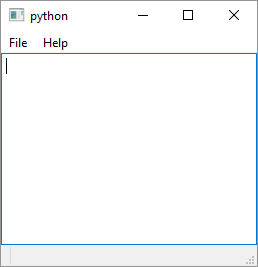Menus

1
2
3
4
5
6
7
8
9
10
11
12
13
14
15
16
17
18
19
20
21
22
23
24
25
26
27
28
29
30
31
32
33
34
35
36
37
38
39
40
41
42
43
44
45
46
47
48
49
50
51
52
53
54
55
56
57
58
59
60
61
62
63
64
65
66
67
68
69
70
71
72
73
74
75
76
77
78
79
80
81
82
83
84
85
86
87
88
# The QMenu class provides a menu widget for use
# in menu bars, context menus, and other popup menus.
# The QAction class provides an abstraction for user commands
# Same action objects can be added to
# menus, toolbars and keyboard shortcuts.
import sys
from PySide6.QtGui import QAction
from PySide6.QtWidgets import (QApplication, QMainWindow,
QTextEdit, QLabel, QMessageBox)
class Editor(QMainWindow):
def __init__(self):
super().__init__()
self.text_edit = QTextEdit()
self.setCentralWidget(self.text_edit)
self.label = QLabel()
self.statusBar().addWidget(self.label)
self.text_edit.textChanged.connect(self.on_text_changed)
# You can access the main window QMenuBar
# using QMainWindow.menuBar()
menu_bar = self.menuBar()
# 1 - Create a QMenu instance using QMenuBar.addMenu()
# Use the ampersand to make keyboard shortcuts work.
file_menu = menu_bar.addMenu('&File')
# 2 - Create a QAction instance.
# Connect a slot to its triggered signal.
# Set Editor as QAction's parent.
exit_action = QAction(self)
exit_action.setText('Exit')
exit_action.setShortcut('Alt+X')
exit_action.triggered.connect(QApplication.quit)
# 3 - Add action to the menu.
file_menu.addAction(exit_action)
# Repeat the steps for each menu item
help_menu = menu_bar.addMenu('&Help')
about_action = QAction(self)
about_action.setText('About')
about_action.triggered.connect(self.show_messagebox)
help_menu.addAction(about_action)
def on_text_changed(self):
cursor = self.text_edit.textCursor()
size = len(self.text_edit.toPlainText())
x = str(cursor.blockNumber() + 1)
y = str(cursor.columnNumber() + 1)
self.label.setText('Chars: {}, Ln: {}, Col: {}'.format(size, x, y))
def show_messagebox(self):
messagebox = QMessageBox()
messagebox.setText('PySide6 menu example')
messagebox.exec()
if __name__ == '__main__':
app = QApplication(sys.argv)
editor = Editor()
editor.show()
sys.exit(app.exec())
The QMenuBar class represents a horizontal menu bar, the QMenu class represents a menu widget and the QAction class represents user commands. To add drop-down menus to your main window
-
Get the reference to the main window menu bar using
QMainWindow.menuBar()and add the menu to it usingQMenuBar.addMenu(). -
Create a
QActionobject and connect a slot to itstriggeredsignal. TheQActionneeds to live for the entireEditorlifetime so set it as its member variable. -
Add the action to the menu using the
QMenu.addAction()method.
Optionally you can assign keyboard shortcuts to menus (accelerators) adding ampersand characters to their text. For instance, &File will open the File menu. Adding an ampersand does not work for QAction objects so you need to add keyboard shortcuts to them using QAction.setShortcut()